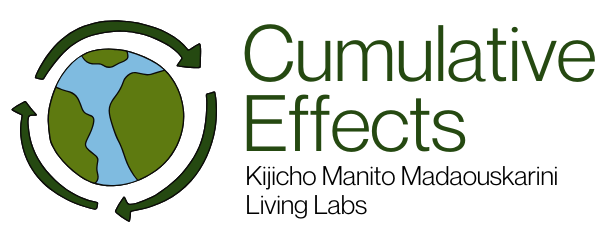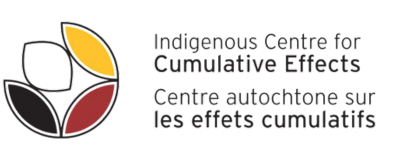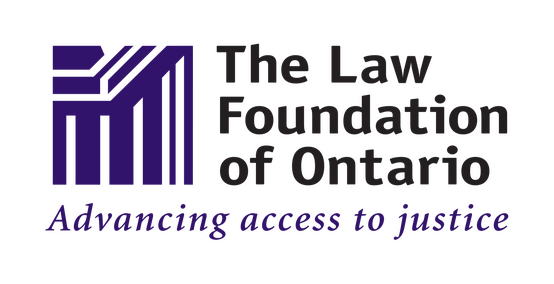
Cumulative Effects within our traditional territory.
Kijicho Manito Madaouskarini Cumulative Effects Project
This 2-year project will focus on enhancing environmental stewardship capacity, particularly in the protection and restoration of the St. Lawrence Watershed which includes the Shawashkong (York River). This project will integrate traditional Algonquin knowledge with modern certifications in environmental management, including riparian shoreline protection, stormwater management, source water testing, and erosion control. By combining these skills, KMM will position itself as a leader in riparian habitat conservation and sustainable land management.A core aspect of the project will be ensuring just transitions into the green economy by upskilling community members through both in-person and virtual certifications. The project will engage youth, incumbent laborers, and volunteers in hands-on activities such as habitat restoration, species monitoring, and invasive species management. These efforts are designed to inspire and equip the next generation with valuable skills for future careers in environmental conservation.
Additionally, the project will focus on species-at-risk recovery, including the restoration of critical habitats for species like the Monarch butterfly and endangered vascular plants. GIS mapping and data analysis tools will be employed to track environmental changes and support decision-making, empowering KMM to monitor cumulative effects and implement science-based conservation strategies.Key measurable outcomes of the project will include a reduction in erosion rates, an increase in native plant species along riverbanks, and improvements in water quality and biodiversity. These initiatives will also support broader national and international environmental goals, such as the United Nations Declaration on the Rights of Indigenous Peoples (UNDRIP) and Canada’s Truth and Reconciliation Calls to Action. Through these efforts, KMM will reinforce its sovereignty, ensure sustainable environmental stewardship, and fulfill its duty to consult and protect natural resources for future generations.
Just Transitions into the Labour Force
Upskilling through certifications.
Blending Algonquin wisdom with modern accreditations.
Advancing as Environmental Stewardship Leaders
As an Algonquin Community living on riparian territory, KMM seeks to advance our community as skilled professionals who possess the traditional wisdom, knowledge, and accreditations required to be leaders in environmental stewardship. Building labour capacity around riparian watershed protection and climate resilience aligns with key reconciliation principles by centering Algonquin knowledge at the heart of environmental stewardship.
Blending Traditional Knowledge with Professional Upskilling
By leading projects in riparian shoreline habitat stewardship, invasive species management, and sustainable source water protection practices, we will achieve measurable outcomes. These include just transitions into the labour force that blend our traditional knowledge while upskilling KMM members to advance as professional, credentialed, and adaptive stewards of our land.
Certifications for New Environmental Responsibilities
KMM has identified several entry-level, in-person and virtual certifications in riparian shoreline habitat protection, stormwater management, source water protection and testing, and erosion and sediment control. These certifications will equip our labourers to take on new and pivotal responsibilities in environmental monitoring, impact assessment, and policy consultation.
Supporting UNDRIP and Truth and Reconciliation Goals
These outcomes support UNDRIP Article 29 (environmental protection) and the Truth and Reconciliation Commission's Call to Action 92 (Indigenous inclusion in economic development). Legally, this mandate fosters economic justice, addressing Canada's climate and employment goals while reinforcing Algonquin sovereignty and our right to be stewards of our traditional lands.
Consultation & Engagement Training
Training to lead in environmental stewardship.
Engaging our Community in hands-on watershed protection.
Short-Term Goals
KMM aims to raise awareness of watershed protection, monitoring, and conservation by actively engaging young people, volunteers, Algonquin knowledge keepers, and stakeholders from various sectors in hands-on, entry-level activities. By involving participants in achievable tasks, we intend to spark interest in watershed management among entry-level and incumbent laborers, as well as job-ready youth.Through practical experience in restoring and revitalizing key shoreline and aquatic ecosystems, we hope to inspire a new generation to take an active role in safeguarding our environment while gaining valuable skills for future careers in this vital field.One immediate action KMM is undertaking is collaborating with stakeholders and experts to learn best practices by actively participating in consultation meetings and site visits to areas of concern.
Long-Term Objectives
KMM seeks to provide comprehensive skills training for incumbent laborers, volunteers, and youth to adapt to the evolving demands of watershed protection and to effectively address the cumulative effects of human development. This initiative aims to facilitate a just transition into the labor force, enabling KMM to fulfill its duty-to-consult obligations in areas such as fish habitat monitoring, shoreline restoration, erosion mitigation, and road salt pollution testing. By equipping our community with these essential skills, we aspire to position ourselves as leaders and active stakeholders, delivering comprehensive on-site services across various watershed conservation sectors. This strategic approach ensures sustainable environmental stewardship and advances our Community's role in preserving and protecting our natural resources.We are committed to enhancing our knowledge and interpretation of the Environmental Assessment (EA) Act, the Ministry of Natural Resources and Forestry's (MNRF) Resource Stewardship and Facility Development Class EA and the Ontario Waterpower Association (OWA) Class EA.
Leadership in Cumulative Effects Management
Hands-on environmental action.
Protecting the watershed for future generations.
Commitment to Protecting the St. Lawrence Watershed
KMM is dedicated to protecting the St. Lawrence Watershed by ensuring the provision of clean water, maintaining healthy ecosystems, and preserving biodiversity. These efforts are essential for the well-being of both upstream and downstream communities, as well as the overall environmental health of the Great Lakes system.
Leading Watershed Protection Through Community Engagement
KMM seeks to bring our Community to the forefront of watershed protection by leveraging our ability to organize and unite municipal, public, and private sector partners. By involving our youth, incumbent laborers, mid-career professionals, and aging adults in building community resilience alongside watershed rehabilitation through volunteerism and hands-on local action, we aim to foster a collaborative approach to environmental stewardship.
Developing Comprehensive Strategies for Environmental Challenges
Through extensive consultations, KMM recognizes the need to develop a comprehensive approach to enhance our Community's capacity to address the environmental challenges facing the Shawashkong (York) River, part of the St. Lawrence Watershed within the Great Lakes Drainage Basin. We have engaged in conversations that have enabled us to build a forward-moving strategy with accompanying short- and long-term action steps.Our Community requires upskilling and accreditation to make fair and just transitions into the green sector labor force and to effectively fulfill our consultation obligations related to watershed management, monitoring, protection, and conservation.
Ecosystem Protection
Targeted habitat rehabilitation.
Supporting native plant species recovery in the Shawashkong watershed.
Action Step: Arthropods - Riparian Monarch Habitat Restoration and Rehabilitation
KMM is initiating a Monarch butterfly habitat restoration and rehabilitation project to support nectaring, breeding, and roosting needs. This effort will target at least 5-hectare sites or contiguous parcels that together meet or exceed this size along riparian zones.This specialized habitat restoration focuses on Monarchs, distinct from general pollinator gardens, and aligns with the Species at Risk Act (SARA) and the Habitat Stewardship Program for Terrestrial Species at Risk.The initiative prioritizes the restoration of critical habitats and aims to achieve measurable recovery goals, including:
Increasing milkweed availability
Establishing diverse native nectar sources
Supporting Monarch migration and breeding
Population objectives include increasing the local Monarch breeding population over five years.
Population objectives include increasing the local Monarch breeding population over five years. Success will be tracked through annual monitoring, focusing on egg and larvae counts.
Action Step: Vascular Plants - Riparian Rehabilitation on the St. Lawrence Watershed
This program will restore 10 hectares of riparian habitat along the St. Lawrence Watershed to facilitate the recovery of species such as Bird’s-foot Violet, Colicroot, Eastern Prairie Fringed Orchid, Hairy Valerian, and Virginia Goat’s-rue.Key deliverables include:
Planting thousands of native vascular plants
Stabilizing riverbanks using native grasses and shrubs
Reducing soil erosion to improve habitat sustainability
Measurable outcomes are an increase in suitable habitat and population growth of targeted species within five years. Strategic alliances with Watersheds Canada, the Ministry of Natural Resources (MNR), and Quinte Conservation Authority will provide essential technical expertise, monitoring, and stewardship to ensure alignment with SARA’s recovery objectives for species at risk.
Capacity Building in the Community
Mapping our heritage.
Empowering our Community with skills and knowledge.
Investing in GIS Technology for Effective Territory Management
Investing in GIS mapping and training is critical for Kijicho Manito Madaouskarini (KMM) to effectively manage and protect our territory. GIS technology enables precise asset mapping and environmental monitoring, essential for assessing the cumulative effects of human activities and modeling potential future scenarios. By acquiring additional GIS systems and training more staff, we can enhance our capacity to monitor environmental changes, detect trends, and support data-driven decision-making. Moreover, GIS mapping allows us to visualize data in ways that are easily understood by community members and stakeholders, facilitating informed discussions and collaborative conservation efforts.
Current Investments and Technological Enhancements
KMM has invested precision GPS devices & training that offers sub-meter accuracy for geolocation data. This technology is instrumental in mapping water sample sites and tagging fish, integrating geo-data into a comprehensive database that informs our environmental assessments.
Preserving Heritage and Ensuring Community Safety
GIS mapping is not just about data collection; it is about preserving our heritage and ensuring safety. QR codes linked to geolocations can guide community members by identifying safe areas and unexplored regions of the Shawashkong, which is crucial for reconnecting with ancestral travel routes and trade fisheries.
Leading in Watershed Conservation and Management
These investments are vital for KMM to lead in watershed conservation and management by demonstrating the importance of precise, science-based approaches in environmental stewardship. It not only facilitates KMM's role in fulfilling duty-to-consult mandates but also ensures that we have the required accreditations to be actively engaged stakeholders in environmental stewardship and sustainable development.
Commitment to Training and Capacity Building
Our strategic focus on training and capacity building underscores KMM's commitment to empowering the community with the necessary skills and knowledge to participate in and benefit from the evolving green economy, fostering long-term environmental and economic sustainability.
Monitoring & Data Collection
Stewardship through sampling and data recording.
Community involvement fosters responsibility.
Monitoring Framework for the Shawashkong River
To protect the Shawashkong River's riparian ecosystems and enhance biodiversity, a comprehensive monitoring framework will be established in alignment with local, provincial, and federal environmental goals, and guided by Algonquin-led stewardship. By 2025, monitoring stations will be strategically placed to track water quality, flow rates, and biodiversity. These locations will be selected in collaboration with stakeholders to ensure cultural and scientific relevance. Monthly aerial surveys will be conducted to monitor shoreline health, sediment deposition, and vegetation changes, using GIS technology to map and track critical shifts over time.An integrated data model will combine real-time station data and drone imagery to assess ecosystem health and identify priority restoration areas. KMM will establish a permanent monitoring schedule for key areas, such as the causeway on South Baptiste Lake Road, collaborating with partners to analyze data and monitor trends effectively.
Community Engagement & Capacity Building
KMM is committed to engaging the community in stewardship activities. Local youth and volunteers will participate in regular sampling and data recording to foster a sense of ownership and care for the river. Additionally, KMM will provide training to members on integrating collected data into GIS systems, which will enhance decision-making for watershed management. This approach will also address the impacts of road salt pollution on local water systems.By focusing on data collection, community involvement, and building local capacity, KMM aims to ensure the long-term health of the Shawashkong River and its surrounding ecosystems.
Data Analysis & Reporting
Integrating traditional knowledge with modern science.
Data-driven reporting to guide habitat restoration.
Data Collection, Analysis & Implementation
This initiative will integrate modern scientific methods with traditional ecological knowledge, ensuring a holistic understanding of the ecosystem.Our focus will be on analyzing water quality, land use, and biodiversity indicators using advanced tools combined with our inherent knowledge as stewards of the land. We aim to identify critical cumulative impacts on the ecosystem.By the second year, KMM will independently implement controlled practices to reduce erosion and water contamination. This will include replanting native terrestrial species, identifying potential sites for habitat restoration, and assessing the presence of target species. These efforts will inform stewardship projects, carried out in collaboration with our identified partners.
Reporting & Restoration
Effective data collection and analysis will be followed by comprehensive reporting, enabling KMM to share findings with partners and our Community. This reporting will guide efforts to restore habitats for target species and influence land management practices to improve habitat quality.Through this approach, we will advocate for sustainable practices that promote long-term ecological health.
Cumulative Effects Policy, Advocacy & Development
Restoring the Shawashkong River through culturally informed strategies.
Empowering KMM leadership in environmental governance and restoration.
Strengthening Algonquin Expertise in Cumulative Effects Management for the Shawashkong River
Kijicho Manito Madaouskarini is advancing its leadership in environmental governance by developing local skills and capacities for cumulative effects management. This initiative aims to pioneer new rehabilitation strategies for the Shawashkong River, which spans the Madawaska Valley, Hastings Highlands, Bancroft, and Carlow Mayo regions.
Key Goals
Algonquin Leadership in Environmental GovernanceEmpowering KMM to lead and influence environmental decision-making processes, ensuring culturally informed, sustainable policies are at the forefront.Building Local ExpertiseDeveloping specialized skills and knowledge for cumulative effects monitoring, fostering local employment opportunities in environmental stewardship.Implementation of Culturally Informed PoliciesCreating policies grounded in Algonquin knowledge and values to protect the Shawashkong River from long-term environmental degradation.Permanent Monitoring StationsEstablishing long-term monitoring stations and adaptive management plans led by Algonquin teams to ensure ongoing sustainability and leadership in environmental management.
Restoration and Conservation Efforts
KMM is committed to restoring shoreline areas to prevent erosion and enhance aquatic habitats. Restoration efforts include planting native vegetation and rehabilitating the shoreline as part of a broader strategy to improve the overall health of the Shawashkong River system.
Conservation of Species-at-Risk
Efforts will also focus on assessing how habitat protection and stewardship have benefited at-risk plant species. This evaluation will guide future conservation strategies and ensure the continued preservation of vulnerable species.By combining traditional Algonquin knowledge with modern environmental practices, KMM is actively leading the charge to restore and protect the Shawashkong River, ensuring its vitality for future generations.
Clarifying & Extending the Duty to Consult
Ensuring Indigenous voices are heard.
Partnerships for sustainable development and stewardship.
Inherent Rights and Legal Obligations
The inherent rights and sovereignty of Algonquin Communities over our traditional territories are recognized both culturally and legally. These rights are not only a matter of respect but are also protected by the "Duty to Consult," a fundamental legal obligation in Canada. This duty compels governments—and, increasingly, private sector partners—to engage with Indigenous communities when decisions may affect their rights, lands, or interests.For Kijicho Manito Madaouskarini, this obligation represents a vital opportunity to ensure that Indigenous voices are central to any actions that impact our territories. Failure to consult risks violating these rights and deepening historical injustices.
Collaborative Environmental Stewardship
In keeping with this legal and moral obligation, KMM is actively reaching out to both public and private partners to forge a collective approach to environmental stewardship. Together, we are working to address the critical challenges facing the Shawashkong River. This strategic framework, developed through extensive consultation, includes both immediate and long-term actions to enhance our Community’s capacity for environmental protection, monitoring, and conservation.Recognizing the river’s profound environmental, cultural, ecological, and economic significance is a necessary first step. The cumulative impacts of human development, industrial activities, and climate change make it imperative to take urgent and sustained action to preserve this watershed for future generations.
Partnerships for Sustainable Development
KMM’s outreach efforts reflect the essence of the Duty to Consult by ensuring that meaningful collaboration and engagement occur at every stage. By bringing together government bodies, private enterprises, and community stakeholders, KMM fosters partnerships that respect Indigenous sovereignty while promoting sustainable development.Our commitment to protecting and rehabilitating the Shawashkong River system, a vital part of the broader St. Lawrence Watershed, aligns with this vision.
Leading by Example
This comprehensive approach is not only about environmental stewardship but also about cultural preservation and the sustainable use of natural resources. Through strategic planning, stakeholder engagement, and the integration of traditional knowledge, KMM seeks to lead by example.By emphasizing the Duty to Consult and actively engaging partners with a shared goal, we aim to ensure the long-term protection of our natural resources for future generations.
Get Involved
Sign up now.
We are working to address the critical challenges facing the Shawashkong (York River). Come join us!
Partners & Sponsors
A project of the KMM Negotiation Team.
This project is made possible through funding provided by Indigenous Centre for Cumulative Effects. Their mission is to create networks and develop and share knowledge to empower community-based approaches to culturally relevant cumulative effects assessment, monitoring and management.
Additional funding provided by The Law Foundation of Ontario under the KMM Consultation Knowledge Building, Interpretation, and Implementation Project.
While financially supported by The Law Foundation of Ontario, Kijicho Manito Madaouskarini is solely responsible for all content.

The KMM Harvest & Resources Portfolio is managing our traditional territory through sustainable use of natural resources & preservation of our cultural practices and values.
The KMM Algonquin Consultation Portfolio is dedicated to reasserting the role of Algonquins as valuable consultation partners in the public & private sectors.
Kijicho Manito Madaouskarini are a resilient & proud Algonquin People with a sacred traditional territory & a rich cultural heritage. To learn more about us, visit kijichomanito.com



